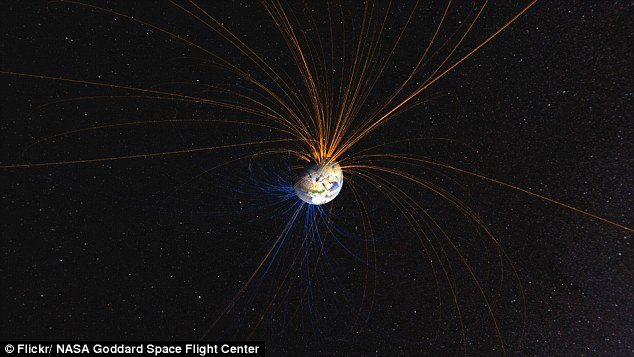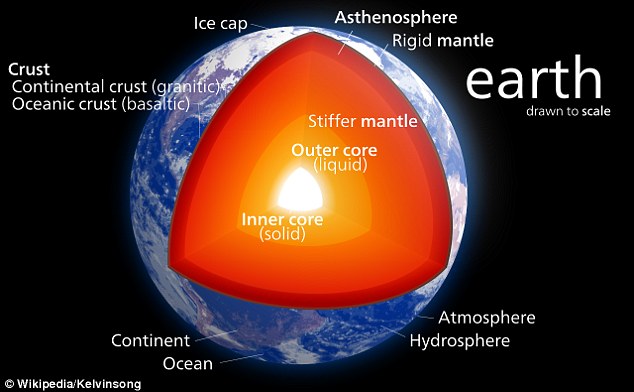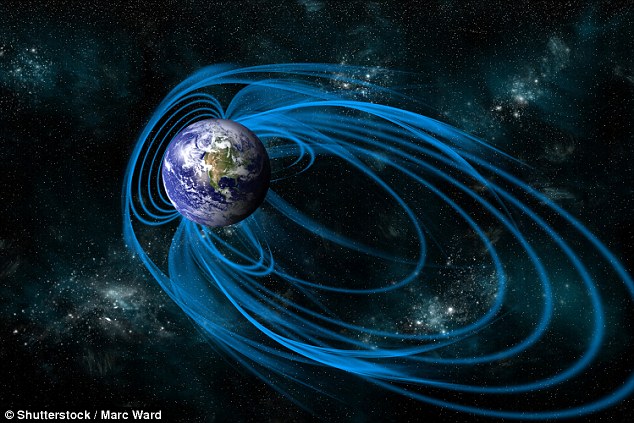What the Earth's magnetic field sounds like: Listen to the 'symphony' of strange pops and whistle created by our planet
- Earth's magnetosphere is a magnetic field that protects us from space radiation
- Satellite recordings show sound waves resonating with the magnetosphere
- Plasma in space interacts with magnetic fields to produce magnetosonic waves
- We can't hear these waves in space – they're below the human hearing threshold
- But satellites can pick up the sound and we can then amplify them and listen
- This show's that we are living inside a massive, magnetic musical instrument
The ancients believed that the Earth was surrounded by celestial spheres, which produced divine music when they moved.
We lived, so to speak, in a huge musical instrument. This may sound silly but modern science has proved them right to a certain extent.
Satellites recording sound waves resonating with the Earth's magnetosphere – the magnetic bubble that protects us from space radiation – show that we are indeed living inside a massive, magnetic musical instrument.
Scroll down for videos
There are two key things which control how the notes of musical instruments sound: the size and shape of the instrument and the speed of sound throughout it.
These determine the pitch of the notes and the timbre, the character or quality of the sound, via the standing waves or resonances that are excited within the instrument as sound waves bounce around it.
It's elegantly simple, yet explains the rich variety of musical sounds that are possible.
The same is true within Earth's protective magnetosphere, which is carved out by the solar wind.
There are always a few sound waves – oscillations in pressure which travel through the medium that they're in – travelling around in space.
Well, they aren't exactly the same type of sound waves that we get on Earth.
Space is filled with plasma rather than normal gas: a different state of matter made of charged particles which can generate and be affected by electric and magnetic fields.
These kinds of interactions can give rise to the plasma-equivalent of sound waves: magnetosonic waves.

Space is filled with plasma rather than normal gas: a different state of matter made of charged particles which can generate and be affected by electric and magnetic fields. These kinds of interactions can give rise to the plasma-equivalent of sound waves: magnetosonic waves
These too are pressure waves, but with some added magnetism.
Such 'magnetosonic' waves can bounce around within the magnetosphere and often set up 'resonances', where the frequency is just right so that these waves grow and grow in energy rather than fizzling out quickly.
Most musical instruments support just one type of resonance – be that the vibrations of a string such as in a guitar, surface waves on a membrane like on a drum, or sound within a cavity like in a flute.
However, the magnetosphere has analogues of all three of these types of resonance going on at once.
Another difference between Earth's magnetic instrument and the ones we're more used to is how it changes in time.
Play a note on a musical instrument a few minutes, hours or even days apart and you wouldn't expect much of a difference in the sound produced.
That's because not much has changed.
Sure, eventually the instrument may need retuning by say tightening up the strings, but that's usually after quite some time.

At the heart of the Earth is a solid inner core, two thirds of the size of the moon, made mainly of iron. At 5,700°C, this iron is as hot as the sun’s surface, but the crushing pressure caused by gravity prevents it from becoming liquid
The magnetosphere, on the other hand, is almost always changing – it grows and shrinks in direct response to the ever fluctuating solar wind.
One would imagine this should change the notes of the magnetosphere, given how a musical instrument works.
This is a topic I've been working on recently.
The problem is that you can't just listen to how the notes change because it's often not possible to be sure what triggered the waves detected or what sort of resonance built up, simply because we don't have satellites placed at all points throughout this 'instrument' listening to these sounds.
One potential way around this is to calculate how all the different types of notes should change using computer models of the magnetosphere under the different observed conditions.
This approach has suggested a considerable amount of variability in these notes, some 35-105%.
This is comparable to between five semitones and an entire octave.
Thankfully, these models have also has revealed at least some of the controlling factors such as the density of the solar wind.
Of course, these are only calculations and need to be tested against reality to be sure, so there's still more work to do.
We can't actually hear these magnetosonic waves in space – the levels are far below the human hearing threshold.

Satellites recording sound waves resonating with the Earth's magnetosphere – the magnetic bubble that protects us from space radiation – show that we are indeed living inside a massive, magnetic musical instrument. Pictured is an artist's impression of the Earth's magnetosphere
But satellites can pick up the sound and we can then amplify them and squash them in time to make them audible.
These notes are hidden among the full set of space sounds I've posted online and now you can download the whole lot to do what you like with them.
In fact, I'm inviting short films that incorporate these sounds in some creative way as part of a competition.
This is your chance to play the strange magnetic musical instrument that you've unwittingly been living inside your whole life – whether you manage to produce divine melodies or not.
Martin Archer, Space Plasma Physicist, Queen Mary University of London
This article was originally published on The Conversation. Read the original article.
Most watched News videos
- Scottish woman has temper tantrum at Nashville airport
- Tesla Cybertruck explodes in front of Trump hotel in Las Vegas
- Mass panic as New Orleans attacker flies down Bourbon street
- Shocking moment zookeeper is fatally mauled by lions in private zoo
- Horrific video shows aftermath of New Orleans truck 'attack'
- Meghan Markle celebrates new year in first Instagram video
- Tesla Cybertruck burns outside Trump hotel in Las Vegas
- See how truck that drove into crowd made it through police barrier
- Cheerful Melania Trump bops to YMCA at Mar-a-Lago NYE bash
- New Orleans terror attack suspect reveals background in video
- Plane passenger throws drink at flight attendant in boozy fight
- Horrifying moment yacht crashes into rocks and sinks off Mexico coast


























































































































































































































































